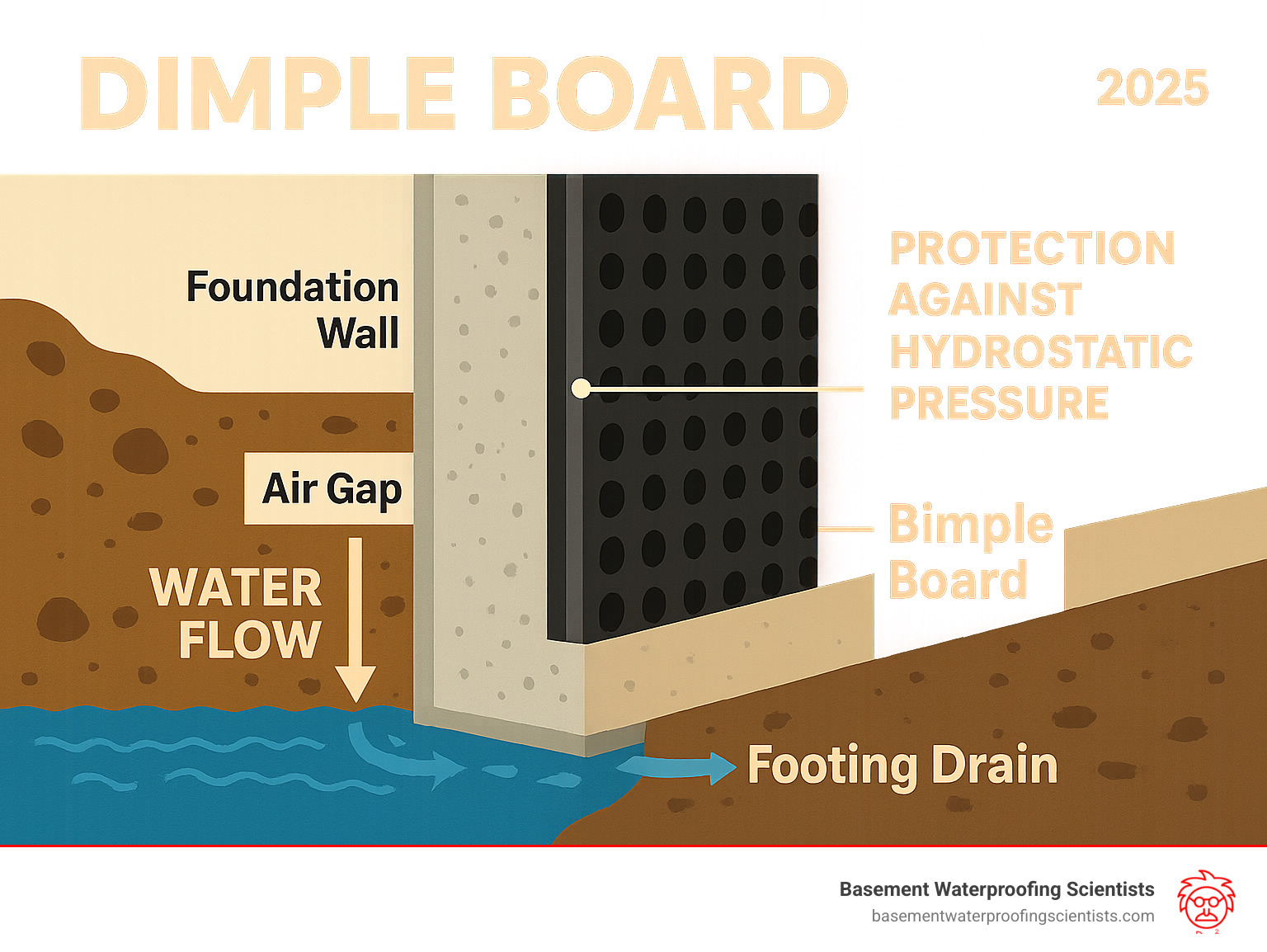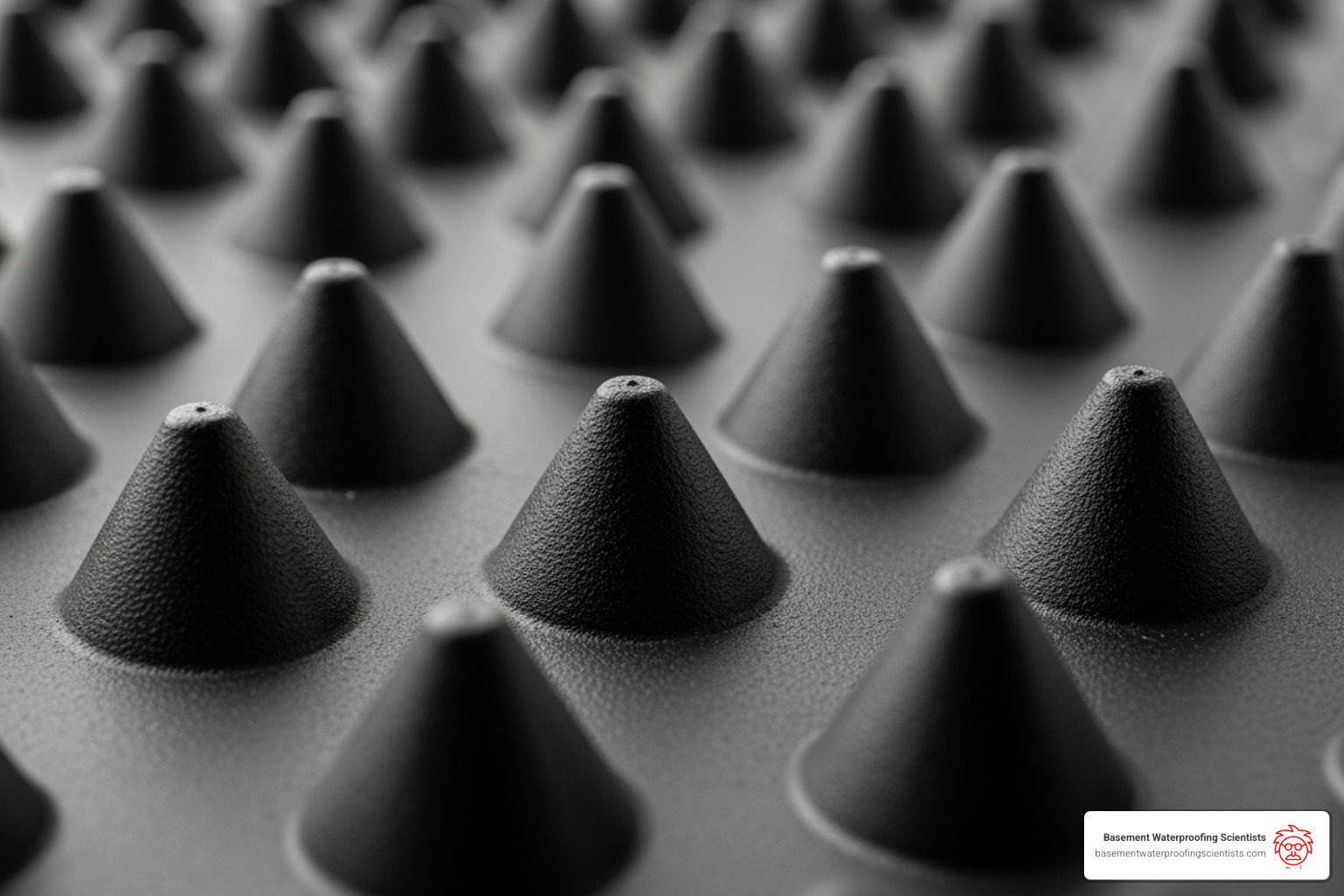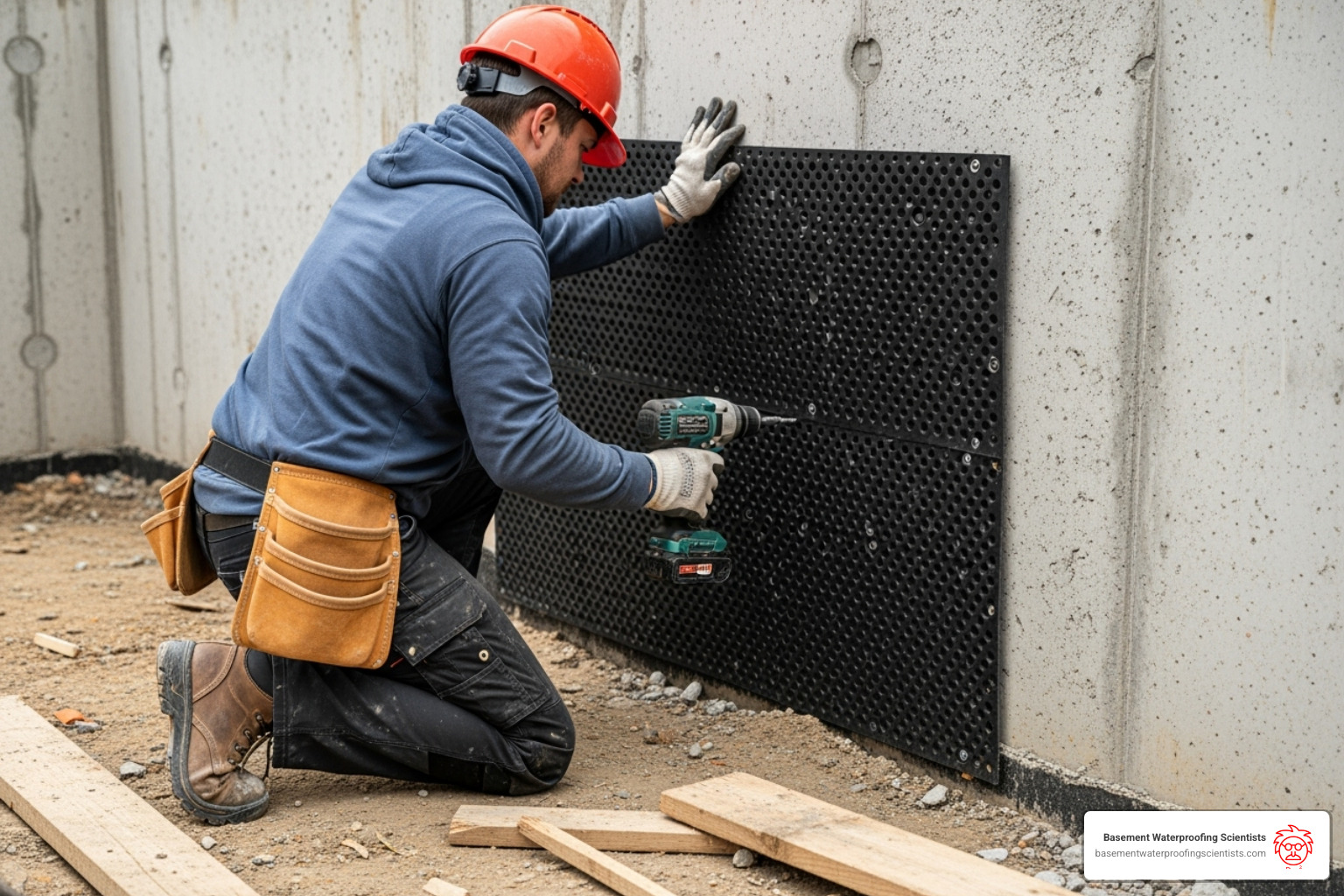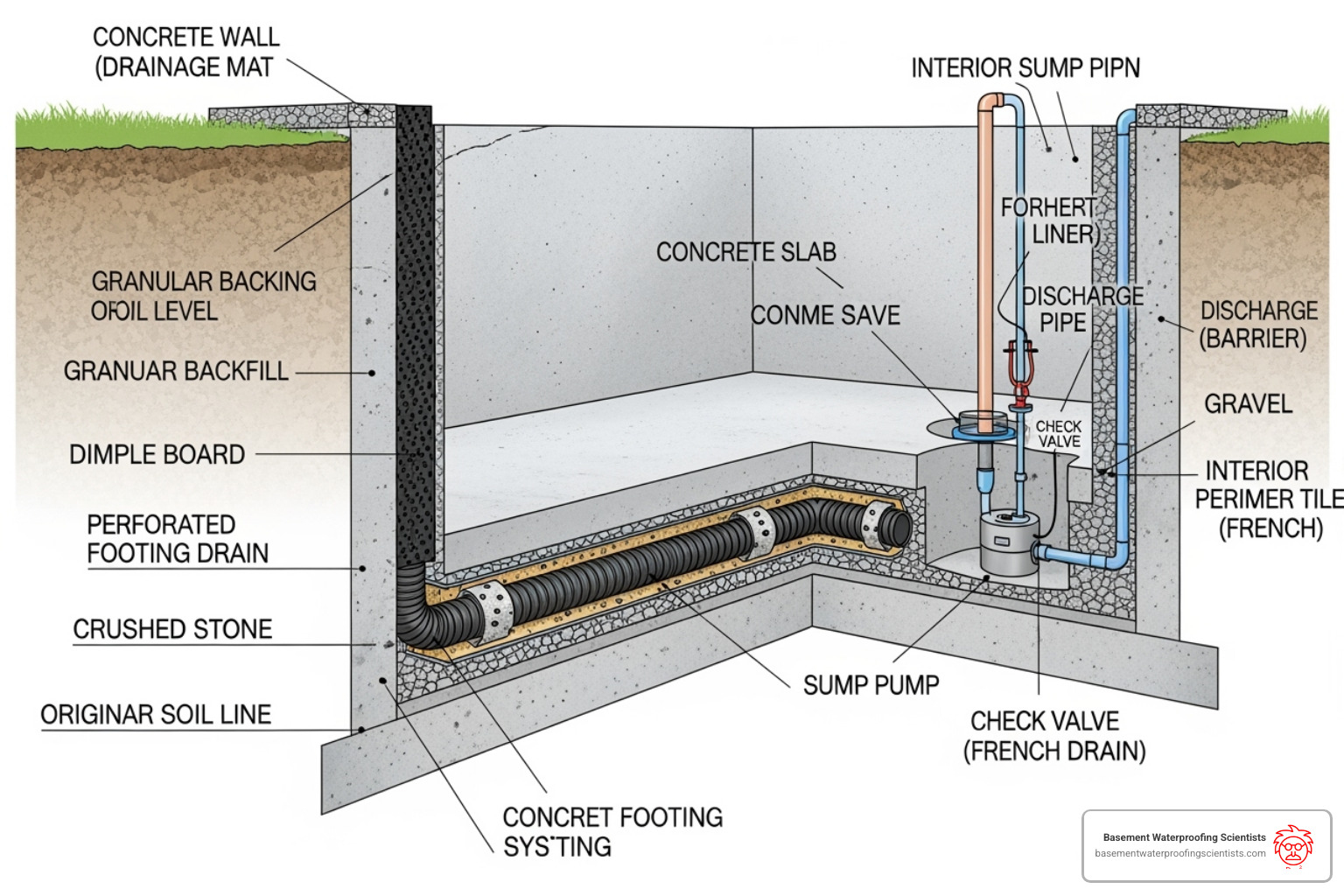Why Dimple Board is the Game-Changer Your Foundation Needs
Dimple board is a semi-rigid, three-dimensional HDPE plastic membrane. It creates an air gap between wet soil and your foundation wall, allowing moisture to drain away while protecting your basement from water intrusion.
Key Benefits of Dimple Board:
- Creates drainage channels to direct water to footing drains
- Relieves hydrostatic pressure against foundation walls
- Spans foundation cracks, maintaining protection as concrete settles
- 50+ year lifespan, outlasting traditional methods by decades
- All-weather installation, unlike temperature-sensitive spray products
Persistent basement moisture is a common problem. 60% of foundations crack within the first year, and traditional tar membranes often fail in 3-5 years. Dimple board is a modern solution that works with your foundation’s natural movement, not against it.
The science is simple: the dimpled pattern keeps soil away from your foundation wall, creating a clear path for water to flow to your drainage system. This prevents the buildup of hydrostatic pressure that forces water through small cracks.
I’m Darin Garvey, and with 30 years in basement waterproofing, I’ve seen dimple board transform countless wet basements into dry, usable spaces. It has revolutionized foundation protection, offering a reliable, long-term solution that addresses the root cause of moisture problems.

What is a Dimple Board and How Does It Protect Your Foundation?
Think of dimple board as your foundation’s bodyguard against water. It’s not average plastic sheeting; it’s an engineered, semi-rigid sheet of high-density polyethylene (HDPE) plastic designed to manage water effectively.
Its unique dimpled pattern is key. These protrusions create a crucial air gap between wet soil and your foundation, forming a drainage channel. This gives water a clear path to flow away from your home instead of pressing against the foundation.
The science is simple: the dimples act as spacers, keeping wet soil from directly touching your foundation. This capillary break prevents moisture from wicking through the walls while relieving hydrostatic pressure—the relentless force of water pushing against your basement.
By creating this barrier, dimple board prevents moisture intrusion and works with your below grade waterproofing system. A protected foundation prevents mold, stops efflorescence (chalky white deposits), and maintains the structural integrity of your home.
The Science Behind the Dimples

Each dimple creates a small air gap that makes a huge difference. Water flow follows the path of least resistance, and the dimples create a highway for moisture to travel down via gravity drainage to your footing drains.
The air circulation in this gap is also important, as it allows the foundation walls to “breathe” and dry out. The soil separation protects your primary waterproofing membrane from damage and prevents dirt from clogging drainage paths. This is crucial for foundation crack protection, as most foundations develop cracks. Unlike rigid coatings that fail when a foundation settles, flexible dimple board bridges small cracks, continuing to protect your basement as your house settles over time.
Dimple board integrates seamlessly with comprehensive basement drain systems for a complete moisture management solution.
How Dimple Board Contributes to a Healthy Home
A dry foundation benefits your entire home. Proper foundation integrity means fewer structural issues and a more stable house. You’ll notice reduced humidity, as dimple board stops ground moisture from entering your basement and rising through your home.
This moisture control dramatically improves basement air quality and eliminates musty odors. For finished basements, dimple board protects your investment from water damage that can destroy drywall, flooring, and belongings.
Most importantly, it reduces long-term repair costs. Prevention is always cheaper than repair. While the average cost for basement waterproofing is between $4,000 and $8,000, it’s far less than major structural repairs or mold remediation. With a 50+ year lifespan, dimple board is an investment that pays for itself many times over.
Dimple Board vs. Outdated Waterproofing Methods
For decades, homeowners relied on waterproofing methods that couldn’t handle the job. Thick black tar, spray-on coatings, and damp-proofing paints often fail under the relentless pressure of groundwater and foundation movement.
Traditional tar membranes typically fail within 3-5 years, and spray-applied coatings often crack as foundations settle. Dimple board offers a different approach: it actively manages moisture while providing decades of reliable protection.
| Feature | Dimple Board (Modern) | Outdated Methods (e.g., Tar, Fluid-Applied) |
|---|---|---|
| Drainage | Actively promotes drainage via air gap | Primarily damp-proofing; no active drainage |
| Durability | 50+ year lifespan; resists backfill abuse | 3-5 year lifespan (tar); prone to drying/cracking |
| Installation Weather | Any weather conditions (extends working season) | Requires dry, above-freezing temps |
| Crack Bridging | Spans foundation cracks effectively | Rigid; prone to failure with foundation movement |
| Lifespan | 50 years (HDPE) | 3-5 years (tar), limited (fluid-applied) |
The difference is clear. While older methods hope to block water, dimple board creates a drainage system that works with your foundation, not against it.
Why Dimple Board is Superior to Outdated Methods
Dimple board‘s superiority comes from better engineering that addresses the root causes of basement moisture.
- Promotes drainage, not just blocking water. Traditional tar or spray coatings create a barrier that fails under hydrostatic pressure. Dimple board is smarter; it creates drainage channels that direct water away before pressure builds.
- Spans foundation cracks with ease. Foundations crack. Rigid coatings crack with them, losing their effectiveness. Flexible dimple board is mechanically fastened, so it moves with your foundation and maintains its drainage capacity.
- Delivers lifetime stability. Tar membranes break down, but dimple board is made from high-density polyethylene engineered to last over 50 years.
- Resists backfill damage. Dimple board is tough enough to handle standard backfilling without expensive protection boards required by many older systems.
- Contains no VOCs or dangerous solvents. Unlike many spray-applied products, dimple board is non-toxic and safe to install.
This represents a clear evolution from simple Damp Proofing vs Waterproofing to scientific moisture management.
Advantages for Contractors and Building Owners
Dimple board creates value for everyone involved.
- Faster installation lowers labor costs. An experienced installer can cover about 130 linear feet per hour, far more efficient than complex spray systems.
- All-weather application extends the working season. Unlike coatings that need perfect weather, dimple board can be installed in almost any condition, keeping projects on schedule.
- Reduced callbacks protect your reputation. Because it performs reliably for decades, contractors see fewer warranty calls, leading to lower costs and happier customers.
- Long service life of 50+ years means homeowners can finish basements with confidence. This increases property value, as a properly protected basement is a major selling point.
- Lower long-term maintenance costs make the initial investment of $4K to $8K a smart financial decision compared to the cost of repeated repairs from failed older systems.
A Complete Guide to Dimple Board Installation
Proper installation is critical for the 50+ year protection dimple board provides. While this is a job for experienced professionals, understanding the process helps you feel confident in the work being done.
Tools and Materials You’ll Need
A professional installation requires specific tools and materials:
- Dimple board rolls: The primary material, planned to cover the foundation with necessary overlaps.
- Cutting and Fastening Tools: A utility knife for trimming and a nail gun or hammer for securing the board.
- Fasteners: The correct type for your foundation, such as concrete nails for poured concrete or corrosion-resistant screws for wood.
- Marking Tools: Measuring tape and chalk line to mark the correct height.
- Sealing Materials: Termination molding to seal the top edge and elastomeric sealant for seams and overlaps. We avoid silicone or latex products that don’t bond properly.
Step-by-Step Installation Best Practices
Our methodical process ensures every detail is right for long-term protection.

- Foundation Preparation: We start by preparing the wall surface, removing sharp edges, clearing debris from the footing, and patching any cracks or holes.
- Marking Grade: A chalk line marks the finished grade to ensure the board extends to the correct height.
- Unrolling and Orienting: The membrane is unrolled with the dimples facing the wall—this is non-negotiable. We start at the footing and work up.
- Fastening: The board is secured with fasteners spaced about 12 inches apart, following specific patterns for maximum stability.
- Overlapping Joints: Vertical joints are overlapped by at least 20 inches and horizontal joints by at least 6 inches to ensure continuous protection.
- Installing Termination Molding: The top edge is sealed with molding to keep out dirt and debris.
- Careful Backfilling: We backfill in compacted layers, ensuring no large rocks or machinery damage the newly installed membrane.
This careful approach ensures your dimple board works seamlessly with your complete How to Waterproof Exterior Foundation Wall system.
The Anatomy of a Complete Wall Drainage System
Dimple board is a key player, but it works best as part of a complete system. A truly dry basement requires every component to work together. After 30 years in this business, I know that piecemeal solutions fail; you need a comprehensive approach.

A complete system creates multiple layers of protection, ensuring that if one component is challenged, the others step up to keep your basement dry.
Key Components of an Effective System
Here’s how the components work together for a bone-dry basement:
- Dimple Board: The first line of defense, creating an air gap and channeling water downward.
- Footing Drain: A perforated pipe along the foundation’s perimeter that collects water from the dimple board and carries it away. For interior issues, a French Drain in Basement can be used.
- Sump Pump: Sits in a pit in your basement floor, collecting water from the footing drain and pumping it safely away from your home. A reliable pump is essential, which is why we offer expert Basement Sump Pump Installation.
- Proper Site Grading: The unsung hero. The ground around your house should slope away from the foundation to keep surface water from reaching the system in the first place.
- Waterproofing Membrane: A primary liquid-applied or sheet membrane applied directly to the foundation wall before the dimple board. The dimple board then acts as a bodyguard, protecting it from damage and relieving pressure.
When combined, these elements actively manage water from the moment it hits your property.
Types of Dimple Board and Their Applications
Choosing the right type of dimple board is crucial.
- Vertical Wall Applications: The most common use, protecting exterior basement, crawl space, and retaining walls.
- Under-Slab Applications: Installed under concrete slabs with dimples down, it creates a capillary break to stop moisture from wicking up through the floor.
- Retaining Walls and Planter Boxes: Ideal for these structures that face constant water pressure.
- Boards with Integrated Filter Fabric: This fabric allows water through but keeps fine soil particles from clogging the drainage channels, which is useful in silty or clayey soils.
- Different Compressive Strengths: Stronger boards are needed for deeper foundations or applications under heavy loads.
- Interior Applications: Can be used on interior walls to direct moisture to a basement drainage channel system, especially with block foundations.
Frequently Asked Questions about Dimple Board
After 30 years in this business, I’ve heard just about every question. Here are answers to the most common ones.
How long does dimple board last?
Dimple board is built to last. Made from tough high-density polyethylene (HDPE), it’s engineered to protect your foundation for over 50 years. This far outlasts old-school tar membranes, which can fail in just 3-5 years. Reputable products often come with warranties up to 40 years, showing confidence in the technology. Installing a dimple board system gives your foundation a lifetime of protection.
Can dimple board be installed on any type of foundation?
Yes. One of the best features of dimple board is its versatility. It can be mechanically fastened to all common foundation types, including poured concrete, concrete block (CMU), and insulated concrete forms (ICFs). We use the correct fasteners for each material to ensure a secure, long-lasting installation. It works for both exterior and interior applications, allowing for a customized waterproofing strategy.
Does dimple board replace the need for a waterproofing coating?
This is a critical question. While dimple board is an excellent drainage plane, it is not a standalone waterproofing solution. Think of it as a great umbrella—you still want a raincoat underneath for maximum protection. For the most reliable defense, we recommend installing dimple board over a primary waterproofing membrane.
The dimple board then acts as a team player. It protects the underlying membrane from damage during backfilling and, most importantly, it relieves hydrostatic pressure. By taking the pressure off, it allows the primary waterproofing to do its job effectively, creating a tag-team that keeps your basement dry for decades.
Conclusion
With three decades in basement waterproofing, I can confirm dimple board is a major advance in foundation protection. It’s a complete shift in how we manage water around your home. Instead of just blocking water, it works with natural forces, creating a drainage path that actively moves water away from your foundation. This is water management at its finest.
The science is solid, and the 50+ year lifespan means you’re making a decision that will protect your home for generations. When combined with footing drains, a reliable sump pump, and proper grading, you create a fortress against moisture.
Here’s what matters: a dry basement, improved air quality, and an end to costly foundation repairs. The average investment of $4K to $8K for a complete system is small compared to the savings in avoided repairs and added peace of mind.
Don’t wait for a damp basement to become a major problem. At Basement Waterproofing Scientists, we’ve been solving these issues for 30 years across Pennsylvania, New Jersey, and Delaware. Our specialized equipment helps us pinpoint leak sources to fix your problem for less, backed by our lifetime guarantee.
Your home deserves the best protection. Dimple board technology, as part of a comprehensive system, is exactly that.
Protect your foundation with a scientifically proven method; Explore our comprehensive basement drainage systems.


